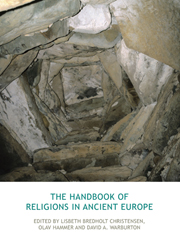Book contents
- Frontmatter
- Contents
- A note on Greek and Latin sources
- Abbreviations and short titles
- 1 Introduction
- PART I PREHISTORIC RELIGIONS
- 2 Studying prehistoric religions
- 3 Prehistoric material and religion: a personal odyssey
- 4 Francesco d'Errico and the origins of religion
- 5 On Palaeolithic religion
- 6 Ian Hodder and the Neolithic
- 7 Neolithic cult images? The testimony of figurines for Neolithic religion
- 8 Religious practices in northern Europe 4000–2000 BCE
- 9 Mythological aspects of Nordic Bronze Age religion
- 10 Religion and society in the Bronze Age
- 11 The religions of prehistoric Europe and the study of prehistoric religion
- PART II ANCIENT EUROPE IN THE HISTORICAL PERIOD
- Timeline of key dates
- Contributors
- References
- Index
5 - On Palaeolithic religion
from PART I - PREHISTORIC RELIGIONS
- Frontmatter
- Contents
- A note on Greek and Latin sources
- Abbreviations and short titles
- 1 Introduction
- PART I PREHISTORIC RELIGIONS
- 2 Studying prehistoric religions
- 3 Prehistoric material and religion: a personal odyssey
- 4 Francesco d'Errico and the origins of religion
- 5 On Palaeolithic religion
- 6 Ian Hodder and the Neolithic
- 7 Neolithic cult images? The testimony of figurines for Neolithic religion
- 8 Religious practices in northern Europe 4000–2000 BCE
- 9 Mythological aspects of Nordic Bronze Age religion
- 10 Religion and society in the Bronze Age
- 11 The religions of prehistoric Europe and the study of prehistoric religion
- PART II ANCIENT EUROPE IN THE HISTORICAL PERIOD
- Timeline of key dates
- Contributors
- References
- Index
Summary
THE CONTEXT OF RELIGIONS
Religion occupies a special place in the culture and daily life of millions of people, and religious traditions have survived for hundreds of generations. They have inspired the arts since prehistory, have been the source of love and hate, and have had a paramount role in the social and intellectual life of humankind. All religions have common denominators, but each religion is different from the others. This millenary pattern has demonstrated its longevity. Major questions arise: Why did human society have the need to create these ideological confraternities? Why is it so important for men and women to demonstrate that one truth is more true than any other? When, how, and why did the pattern of religious behaviour develop?
In previous studies I had reached the conclusion that Homo sapiens developed a package of intellectual capacities which included visual art, complex articulated language, and religion (Anati 1983; 1999). These three elements of culture reflect the skills of analysis, synthesis, symbolization and sublimation which characterize the cognitive system of Homo sapiens. I suggested the presence of a package of religious thoughts, beliefs and rituals which developed before 30,000 years ago, out of which all subsequent religions developed (Anati 1999).
- Type
- Chapter
- Information
- The Handbook of Religions in Ancient Europe , pp. 36 - 44Publisher: Acumen PublishingPrint publication year: 2013



